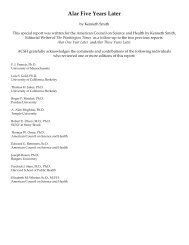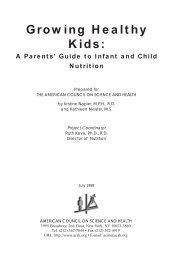The Role of Beef in the American Diet - International Meat Secretariat
The Role of Beef in the American Diet - International Meat Secretariat
The Role of Beef in the American Diet - International Meat Secretariat
Create successful ePaper yourself
Turn your PDF publications into a flip-book with our unique Google optimized e-Paper software.
<strong>The</strong> <strong>Role</strong> <strong>of</strong> <strong>Beef</strong> <strong>in</strong> <strong>the</strong> <strong>American</strong> <strong>Diet</strong><br />
14<br />
U.S. (21). <strong>The</strong> term “lean” means that meat, poultry, or seafood conta<strong>in</strong>s<br />
less than 10 g <strong>of</strong> total fat, 4.5 g or less <strong>of</strong> saturated fat, and less than 95<br />
mg <strong>of</strong> cholesterol per serv<strong>in</strong>g (usually, 3 oz.) and per 100 g (about 3.5<br />
oz.). * Table 3 gives some examples <strong>of</strong> lean meat and poultry.<br />
Producers <strong>of</strong> beef and o<strong>the</strong>r meats have responded to consumers’<br />
concerns about fat and cholesterol by rais<strong>in</strong>g leaner animals, trimm<strong>in</strong>g<br />
more outer fat from retail cuts <strong>of</strong> meat, and produc<strong>in</strong>g lower-fat ground<br />
and processed meat products (23). Lean beef and o<strong>the</strong>r lean red meats<br />
are now readily available to <strong>American</strong> consumers.<br />
Because <strong>of</strong> changes <strong>in</strong> production methods, comb<strong>in</strong>ed with changes<br />
<strong>in</strong> consumers’ food choices, <strong>the</strong> proportions <strong>of</strong> total fat and saturated fat<br />
<strong>in</strong> <strong>the</strong> U.S. food supply contributed by meat/poultry/seafood decreased<br />
from 35 to 25% and from 37 to 26%, respectively, between 1970 and<br />
1994, even though total consumption <strong>of</strong> meat/poultry/seafood actually<br />
<strong>in</strong>creased slightly dur<strong>in</strong>g <strong>the</strong> same period <strong>of</strong> time (23).<br />
Several studies <strong>in</strong> people with high blood cholesterol levels have<br />
shown that a cholesterol-lower<strong>in</strong>g diet that <strong>in</strong>cludes lean red meat is just<br />
as effective <strong>in</strong> reduc<strong>in</strong>g blood cholesterol levels as a similar diet that<br />
<strong>in</strong>cludes only lean “white” meats (poultry or fish) (24–28). <strong>The</strong> results<br />
<strong>of</strong> <strong>the</strong>se studies make sense because <strong>the</strong> cholesterol-rais<strong>in</strong>g saturated<br />
fatty acids <strong>in</strong> meat are found primarily <strong>in</strong> <strong>the</strong> fatty portion <strong>of</strong> <strong>the</strong> meat.<br />
S<strong>in</strong>ce lean meats — <strong>of</strong> whatever color — conta<strong>in</strong> relatively little fat,<br />
<strong>the</strong>y would be expected to raise cholesterol levels less than higher-fat<br />
meats do.<br />
Of course, this does not mean that it is acceptable to eat unlimited<br />
quantities <strong>of</strong> meat. As <strong>the</strong> data <strong>in</strong> Table 3 show, meats do conta<strong>in</strong> saturated<br />
fat and cholesterol, and a person who eats <strong>the</strong>se foods <strong>in</strong> excessive<br />
quantities could exceed <strong>the</strong> maximum <strong>in</strong>take levels <strong>of</strong> <strong>the</strong>se food components<br />
called for by <strong>the</strong> <strong>Diet</strong>ary Guidel<strong>in</strong>es for <strong>American</strong>s and <strong>the</strong><br />
Food Guide Pyramid. In general, though, people don’t eat too much<br />
meat. <strong>The</strong> Food Guide Pyramid calls for 2–3 serv<strong>in</strong>gs per day from <strong>the</strong><br />
<strong>Meat</strong> Group, for a total <strong>of</strong> 5–7 ounces <strong>of</strong> meat or its equivalent. A comparison<br />
<strong>of</strong> <strong>the</strong> Pyramid recommendations with national dietary survey<br />
f<strong>in</strong>d<strong>in</strong>gs from 1994–98 <strong>in</strong>dicated that men eat an average <strong>of</strong> 6.7 ounces<br />
* Ground beef is an exception. At <strong>the</strong> time <strong>of</strong> this writ<strong>in</strong>g, <strong>the</strong> U.S. Department <strong>of</strong><br />
Agriculture had not yet established rules for <strong>the</strong> use <strong>of</strong> terms such as "lean" and "extra<br />
lean" on ground beef, although a proposed rule is currently <strong>in</strong> process (22). Until a f<strong>in</strong>al<br />
rul<strong>in</strong>g is made, different supermarkets may choose to label <strong>the</strong>se products <strong>in</strong> diff e r e n t<br />
ways. Consumers who are look<strong>in</strong>g for <strong>the</strong> leanest ground beef should select products on<br />
<strong>the</strong> basis <strong>of</strong> <strong>the</strong> lean/fat percentages that appear on <strong>the</strong> label. For example, a product<br />
labeled 95% lean (5% fat) is preferable to one labeled 85% lean (15% fat). <strong>The</strong>se percentages<br />
refer to <strong>the</strong> percent <strong>of</strong> fat or lean by weight, not <strong>the</strong> percent <strong>of</strong> calories.










